Most people visit Cordoba to see the Mezquita, Europe's best Islamic site after the Alhambra in Granada, also on our upcoming itinerary of Spain. The massive former mosque - now with a 16th century church in the middle was once the heart of Western Islam and the center of of a cultural capital that rivaled Baghdad and Constantinople. I hope you'll also be amazed by this wonder of the medieval world!














Thank goodness we took a moment to gaze up at the Bell Tower, built about 1600 over the remains of the original Muslim minaret. For four centuries, five times a day, the singing muezzin or cleric rode a donkey up the ramps of the minaret, calling all Muslims in earshot to face Mecca and pray.


The Patio de los Naranjas or Orange Tree Courtyard was a large area that, when this was a mosque, the Muslim faithful would gather to do their ritual ablution or washing of parts of their bodies as required by Muslim law. Like the day before, it was pretty drizzly so we didn't dawdle long admiring the lovely trees.



As we walked from an orchard of orange trees into the former mosque, we were dazzled by the forest of slender columns that had been erected in the 8th century. The more than 800 red and blue columns seemed to recede into infinity "as if reflecting the immensity and complexity of Allah's creation." They were topped by double arches - a round Romanesque one above a Visigothic horseshoe one - made from alternating red brick and white stone. The columns and marble, granite and alabaster capitals - the columns' topmost part - were recycled from ancient Roman ruins and conquered Visigothic churches.
Although the room was enormous, the low ceilings and dense columns surprisingly still conveyed an intimate and prayerful atmosphere. I read the original mosque was far brighter before the Christians renovated the space for their use by closing up the arched entrances we'd seen earlier from the patio and street.
I was more than content to wander around the vast interior to get a sense of, and appreciation of, its beauty before examining its finer details.
Under protective glass on the floor were some mosaics that remained from the early-Christian Basilica of San Vincente built during the mid-6th century Visigothic period. As the mosque was constructed on the site of the church, the mosaics were important to Catholic locals as it proved there was a church here before the mosque. They don't see the mosque was violated by the modern-day church on this spot, but, rather, as a return to the site's original purpose.
It was amazing seeing still the mosaics' vibrant colors and complexity from that ancient church.
It was impossible not to admire the elaborate stucco and tile work throughout.
I appreciated that when the mosque was converted into a church, the structure was virtually unchanged and what we saw was about 70 percent of the original mosque! It was evident that church architects relished the opportunity to incorporate the mosque's sublime architecture into their church.
The Mihrab, the mosque equivalent of a church's high altar, was the focus of the mosque and one of the Mezquita's highlights still today. I could almost picture the original mosque when the dirt floor would have been covered by immense carpets and 200,000 people were praying at once facing the mihrab! Common to all mosques, the mihrab is a decorated niche - but here it was more like a small room - where the imam or prayer leader stands during a service to read scriptures and give sermons. The imam would have spoken loudly into the niche with his back to the masses who could hear him because the architecture worked to amplify his voice.
On display in one corner of the mosque cum church were rare pieces of carved stone that dated to its Visigothic era during the 6th century. Most other stonework had been scrubbed of its Christian symbolism by Muslims so they could be used for the mosque. Prince Abd Al-Rahman bought the church from his Christian subjects before destroying it to build a mosque.
There were lots and lots of chapels scattered throughout the church. Some were completely closed off while others could only be seen through grilles.
The Villaviciosa Chapel was built in 1236 when King Ferdinand III conquered the Arab-controlled city and turned the mosque into a church. Its higher ceiling allowed for windows and more light, both critical to making it appear and feel more like a church.
Unlike so many other churches in Spain, visitors were barred from walking on the tombs of nobles and other important people who chose the church as their final resting place.
The adjacent Royal Chapel was designed for Castile's two Christian kings, Ferdinand IV and Alfonso X and built at the order of King Enrique II in 1371. While it was always completely closed off to the public, we could still look with wonder at the well-preserved Mudejar walls and the crossed arches in the dome.


Nowhere else in the world can one see the combination of Gothic vaulting and Moorish arches!
Having already been fortunate enough to see so many fabulous Treasuries filled with display cases of religious artifacts in other Spanish churches, we couldn't imagine the one at the Mezquita could be grander or bigger.
However, the enormous monstrance was a fabulous attempt by the 16th century Christians to create something exquisite enough to merit being the holder of the Holy Communion wafer. As they believed the wafer actually was Christ's body, it was considered far more important than any relics.
Imagine sharing the responsibility of parading the monstrance through Cordoba's streets each Corpus Christi, sixty days after Easter!
The bottom was silver-plated 18th century Baroque.
One of the canvases in the Treasury depicted King Ferdinand III accepting the keys to the city's fortified gate from the vanquished Muslims.
The black and white marble tomb belonged to Fray Pedro de Salazar y Toledo, the main preacher to two Spanish kings. Later named cardinal by Pope Innocent XI, he's regarded locally as the founder of one of the first public hospitals in Cordoba. Notice the eerie skull and crossbones at the base!
Finally, in the center of the mosque, was the newly restored, towering cathedral oriented in the Christian tradition with its altar at the east end! As we looked up at the rich, gold decorations, it was easy to forget we'd just been in the mosque a few minutes earlier. In 1523 Cordoba's bishop proposed building this grand church in the center of the Mezquita. King Charles I ordered it done even though the town council opposed it.
I will leave it to travel writer Rick Steves who said it best when comparing the two great places of worship and how they reflected the differences between the faiths in the Mezquita: "horizontal versus vertical, intimate versus powerful, fear-inspiring versus loving, dark versus bright, simple versus elaborate, feeling close to God versus feeling small before God."
The few pews in the nave between the altar and the Baroque-era Choir were reserved for nobles only. The peasants listened from the outside. Lay people didn't understand what they were hearing anyway as Mass was only said in Latin until the 1960s.
The Choir's gorgeous stalls, made of New World mahogany, weren't made until 1750. I read that the choir is considered one of the masterpieces of Andalusian Baroque - whatever that is!
Each of the 109 stalls - 108 plus the bishop's throne - contained a scene from the Bible with Mary's life on one side facing Jesus' life on the other.

It was a humbling and awe-inspiring experience being able to visit the Mezquita where centuries of competing history were brought together in a stunning harmony of Islam and Christianity.
Just down from the Mezquita was the Plague Monument and the Triumphal Arch I wrote about in the last post.
Across from the arch was the Roman Bridge that we'd seen, but not walked on, the previous day. You can see the monument on the left in the background. We couldn't believe our lucky stars as the rain gods had disappeared for a while. We were thrilled for however long that lasted!
Walking across the first bridge over the Guadalquivir River brought us to the 14th century fortified gate at the far end. The Calahorra Tower contained a museum of Andalusian life which didn't interest us, so we sat for a while on the other side of the river until it was time to meet Phil, an English friend whom we'd met while traveling in Georgia about a month into this four plus month-long trip.
This was the first time in a long time we've been lucky enough to get together with someone we've gotten to know on one of our long adventures. It was so much fun reconnecting with Phil, on the left, and also meeting his friend, Dave, over wine and tapas near the Mezquita. Steven and I'll be in London at the beginning of October for several days at the end of our six-week trip to the British Isles and hope to see him again if he's not off traveling to Timbuktu!
A much prettier shot of the Mezquita's Bell Tower once the sun was shining! More sunny shots of the Mezquita's exterior follow to give you a greater appreciation of the fabulous place.
Everywhere we turned in the old town were shops selling wonderful leather goods, places always near and dear to Steven as his father used to be in the leather business in tiny Gloversville, NY, before moving his family to Cleveland for graduate school.
As we strolled along the narrow streets, we saw more glorious pots of flowers on the walls, after getting our first glimpses of them the day before. Most of the area around the Mezquita was commercial and touristy, but just a few blocks away seemed to be untouched by tourism and the modern world. We were looking forward to exploring Cordoba's Jewish Quarter that wasn't affected by "the onslaught of tourism and the affluence of tourism of the 21st century."
Rick Steves included in his book a Ten Point Scavenger Hunt of the district which sounded like a hoot as I hadn't participated in one for many decades! The narrow streets were easy enough to find and made sense in hot climates because of the much-appreciated shade they provide. These ones were holdovers from the old Moorish bazaar that had to fit in the protective city walls.
This area was marked by thick, whitewashed walls which served as a kind of natural air-conditioning. I had never known before the chalk ingredient in the whitewash deterred bugs.
Another of the pretty patios Cordoba is so renowned for, particularly in the spring when homeowners open them up for a million visitors to come and see the blooming flowers.
Another feature were iron grilles in front of wooden latticework covering many windows. The latticework came from an era when women, held to extreme standards of modesty, wanted to see out while still maintaining their privacy.
Cordoba is famously a white city so seeing the occasional colorful door or window - mostly added in modern times - was a pleasant change to the boring whitewash.
Riverstone cobbles were cheap and local and provided drains down the middle of a lane. Some of the designs were very attractive in addition to being utilitarian.
We stopped for a few minutes at the Artisan Market, the first crafts market in Spain, to see artists' studios clustered around attractive patios and artists working in leather, glass, textiles and bags.
Cordoba's Jewish Quarter dated from the late Middle Ages, after Muslim rule and during the Christian era. As in so many cities, sadly now little remained. However, the exhibits recounting Spanish Jewish history at the Casa de Sefarad focused on themes such as Jewish celebrations and holidays and Sephardic musical traditions for Jews from Spain or Portugal. Other rooms were dedicated to the Spanish Inquisition.
Right around the corner was the Synagogue built around 1314 and which was in use right until the final expulsion of the Jews in Spain in 1492.
Close by was a statue of the Jewish philosopher Maimonides, known as the Jewish Aquinas who was born in Cordoba and was brought up on Jewish scripture and the philosophy of Aristotle. He was an influential Talmudic scholar, astronomer, and medical doctor.
The last of the items on the scavenger hunt we were able to detect were the remnants of old towers from minarets. Muslim Cordoba peaked in the 10th century with an estimated 600,000 people which meant a lot of neighborhood mosques.
Walking through the Puerta de la Luna or Moon Gate gave us a remarkable view of the City Walls that had been built on the the foundation of Cordoba's Roman walls and dated mostly from the 12th century. These fortifications protected the city's political, religious and commercial sector.
Just outside the gate were statues honoring two other important natives of Cordoba. The first one we saw was of Ibn Rushd, anglicized to Averroes, an Andalusian Muslim philosopher and thinker who wrote about many subjects including medicine, astronomy, physics, etc. He was born in 1126.
Lovely views of the city walls and the approaching storm:
The last statue honored Cordoba native Seneca the Younger who was born about 3 BC and died in AS 65. Drawn to Rome early in life, he received schooling in Stoicism and was known for his oratory skills as well as writing, law and politics. He was a trusted adviser to Emperor Nero until Nero eventually accused Seneca of plotting against him and demanded Seneca kill himself. Seneca complied in true Stoic fashion!
Of the seven original gates, Puerta de Almodovar was considered the best preserved but I didn't know why as it didn't appear any better than the other.
I loved this statue showing a man holding a ladder while his child was watering the pots of flowers on the wall.
My favorite color in the Andalusian region of Spain was this Mediterranean shade of blue we saw in Cordoba.
Other scenes of ever so charming Cordoba that caught my eye:
Next post: A Roman Temple and the pretty Palacio Viana, still in Cordoba.
Posted on January 27th, 2019, from our home in Littleton, Colorado.





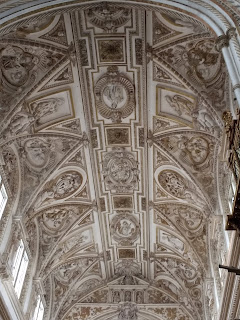








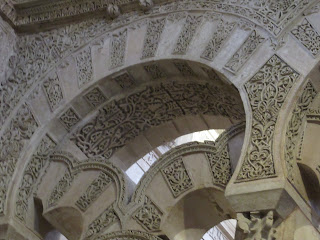

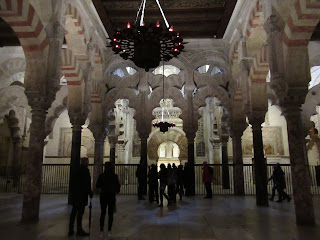



















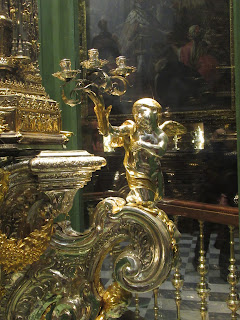



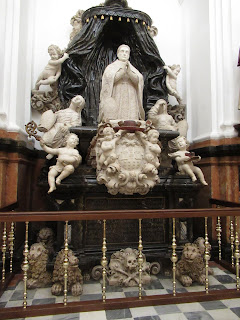






















































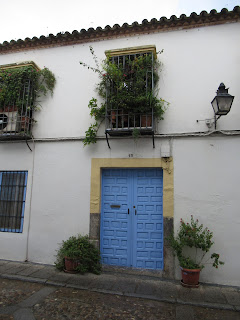





Loved the ceilings. Always look up. Janina
ReplyDeleteJanina,
ReplyDeleteYou know you don't have to remind me about looking up as I always think of you when craning my neck to look at domes of churches and other buildings since your first comment on one of my first posts umpteen years ago!